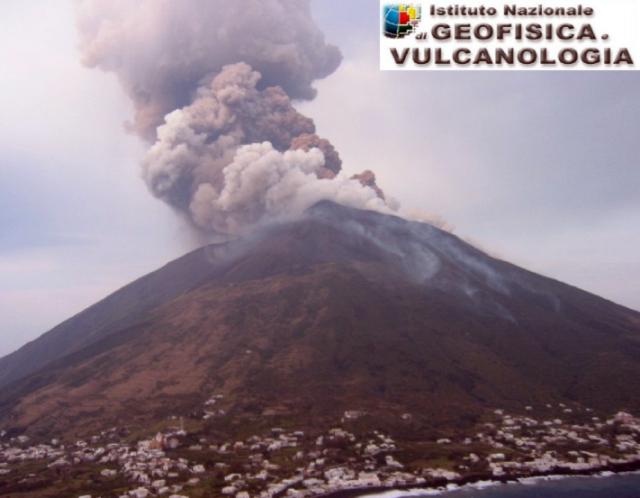Report on Stromboli (Italy) — April 2003
Bulletin of the Global Volcanism Network, vol. 28, no. 4 (April 2003)
Managing Editor: Edward Venzke.
Stromboli (Italy) Strong explosion on 5 April covers much of the summit in pyroclastic deposits
Please cite this report as:
Global Volcanism Program, 2003. Report on Stromboli (Italy) (Venzke, E., ed.). Bulletin of the Global Volcanism Network, 28:4. Smithsonian Institution. https://doi.org/10.5479/si.GVP.BGVN200304-211040
Stromboli
Italy
38.789°N, 15.213°E; summit elev. 924 m
All times are local (unless otherwise noted)
On the morning of 5 April, scientists from INGV-CT were conducting a daily helicopter flight with a portable thermal camera, surveying the active lava flow field on the upper sector of the Sciara del Fuoco, above a flat zone at the base of the 28 December 2002 eruptive fissure. Three vents along this surface were feeding small lava flows, and the summit craters were producing a very diluted gas cloud. A few minutes after the start of the survey, which began about 0900, the gas plume from the craters being blown W was suddenly crossed by a reddish ash emission, which was interpreted as resulting from further collapses within the craters. However, the red ash was soon replaced by darker juvenile material coming from Crater 1 (the NE crater) that formed a hot jet with a cauliflower shape rapidly growing above the crater. A few seconds later, Crater 3 also produced a hot jet of juvenile material. Data from the seismic network confirmed that the explosion began at 0912.
The eruptive process then evolved very rapidly, with jets from craters 1 and 3 joining together. A very powerful explosion pushed the helicopter away from the crater. A mushroom-shaped dark cloud rose from the craters, expanding vertically to an altitude of ~2 km, 1 km above the volcano's summit (figure 73). The eruptive cloud was surrounded at its base by a dark-gray cloud, while it was still expanding vertically and assuming the mushroom shape. Bombs, ash, and blocks fell on the NE flank above 400 m elevation, burning vegetation. Most of the ejecta drifted W, falling on Ginostra (~1.5 km from the summit) and destroying two houses; no people were injured.
 |
Figure 73. Photograph of the expanding eruption plume at Stromboli on 5 April 2003. Courtesy of INGV. |
Continuing the helicopter survey after the eruption, observers saw that the lava-flow field on the upper Sciara del Fuoco was completely covered by a brown carpet of debris ejected from Crater 1 during the initial phase of the event. A thick steam cloud rose above the debris due to vaporization from the wet material by the underlying lava flows. Meanwhile, several alternating black and reddish pulses occurred, mainly from Crater 3. Several fingers of light-brown debris were expanding from the NW flank of Crater 1 along the mid-section of the Sciara del Fuoco. The upper part of the volcano above 700 m elevation was completely covered by pyroclastic products. Within a few minutes after the start of the eruption, the upper Sciara del Fuoco had active flows emerging from the layer of debris covering the lava-flow field. The explosive event caused abundant emission of pumice mixed with small brown scoria. The pumice contained small crystals and was very vesiculated. Lithic fragments of lava with light-gray groundmass and centimeter-sized crystals of pyroxene were common in the pumice.
A helicopter survey on 8 April showed four active vents pouring lava onto the upper Sciara del Fuoco at 590 m elevation. Two of the flows were expanding along the middle Sciara del Fuoco, causing detachment of blocks from the flow front and small rockfalls that reached the sea. Within the summit craters a thick layer of debris had accumulated following the event of 5 April.
Geological Summary. Spectacular incandescent nighttime explosions at Stromboli have long attracted visitors to the "Lighthouse of the Mediterranean" in the NE Aeolian Islands. This volcano has lent its name to the frequent mild explosive activity that has characterized its eruptions throughout much of historical time. The small island is the emergent summit of a volcano that grew in two main eruptive cycles, the last of which formed the western portion of the island. The Neostromboli eruptive period took place between about 13,000 and 5,000 years ago. The active summit vents are located at the head of the Sciara del Fuoco, a prominent scarp that formed about 5,000 years ago due to a series of slope failures which extends to below sea level. The modern volcano has been constructed within this scarp, which funnels pyroclastic ejecta and lava flows to the NW. Essentially continuous mild Strombolian explosions, sometimes accompanied by lava flows, have been recorded for more than a millennium.
Information Contacts: Sonia Calvari, Istituto Nazionale di Geofisica e Vulcanologia, Piazza Roma 2, 95123 Catania, Italy (URL: http://www.ct.ingv.it/).

